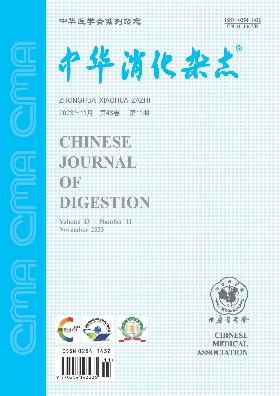Expression of microtubule actin cross-linking factor 1 in gastric carcinoma and its effect on cell invasion and metastasis
引用次数: 0
Abstract
Objective To explore the role of microtubule actin cross-linking factor 1(MACF1) in the metastasis of gastric cancer. Methods From 2009 to 2012, at The First Affiliated Hospital of Zhengzhou University, the paraffin blocks of gastric cancer and normal tissue adjacent to cancer of 107 patients who received radical gastrectomy were collected. The expression of MACF1 in tissues at protein level was detected by immunohistochemical staining. In 2017, at The First Affiliated Hospital of Zhengzhou University, fresh specimens samples of gastric cancer and normal tissue adjacent to cancer of 42 patients who received radical gastrectomy were also collected. The expression of MACF1 at mRNA level was determined by quantitative real-time polymerase chain reaction (PCR). MACF1 knockout gastric cell line was established. The effects of MACF1 on cell migration and invasion were verified by wound-healing test and Transwell assay. The effects of MACF1 on cell microtubule and actin were analyzed by filamentous actin (F-actin) staining. T-test, chi-square test and multivariate analysis were used for statistical analysis. Results The positive expression rate of MACF1 in gastric carcinoma tissues was 71.0%(76/107), which was significantly higher than that of the corresponding normal tissues adjacent to cancer (22.4%, 24/107), and the difference was significant (t=4.145, P=0.016). The expression of MACF1 at mRNA level in cancer tissues of 42 patients with gastric cancer was 6.463±0.672, which was significantly higher than that of corresponding normal tissue adjacent to cancer (1.727±0.331), and the difference was statistically significant (t=6.326, P<0.01). The differences in positive expression rate of MACF1 in different tumor infiltration depth, different TNM stage and lymph nodes metastasis were statistically significant (χ2=1.170, 7.959 and 5.288; all P<0.01). The five-year survival rate of patients with high expression of MACF1 was 32.9% (25/76), which was significantly lower than that of patients with normal MACF1 expression (64.5%, 20/31), and the difference was statistically significant (χ2=25.093, P=0.034). The high expression of MACF1 was an independent prognostic factor affecting overall survival rate in patients with gastric cancer after surgery(hazard ratio (HR)=0.513, 95%confidence interval (CI): 0.411 to 0.922, P=0.038). The results of wound-healing assay showed that at 24 hour after wound the migration ability of MACF1 knockout AGS- MACF1-/- cells was (18.77±3.82)%, which was lower than that of wild type AGS cells ((76.24±5.36)%), and the difference was statistically significant (t=6.249, P=0.014). The migration ability of MACF1 knockout HGC27-MACF1-/-cells was (42.48±7.37)%, which was lower than that of wild type HGC27 cells ((82.35±4.28)%), and the difference was statistically significant (t=5.938, P=0.017). The results of Transwell assay indicated that the number of migration cells of MACF1 knockout AGS-MACF1-/- cells was 87.0±11.0, which was less than that of wild type AGS cells (200.0±16.0), and the difference was statistically significant (t=5.820, P=0.028). The number of migration cells of MACF1 knockout HGC27-MACF1-/-cells was 151.0±13.0, which was less than that of wild type HGC27 cells (268.5±20.5), and the difference was statistically significant (t=4.840, P=0.040). The results of F-actin staining demonstrated that the number of actin filaments of MACF1 knockout AGS-MACF1-/- cells was 216.60±18.09, which was less than that of wild type AGS cells (491.30±5.02), and the difference was statistically significant (t=14.630, P=0.005). Conclusions The abnormally high expression of MACF1 in gastric cancer tissues may be correlated with the poor prognosis of patients with gastric cancer. MACF1 promotes the invasion and metastasis of gastric cancer cells by affecting the formation of F-actin and cell skeleton. Key words: Stomach neoplasms; Actins; Invasion and metastasis; MACF1; Cell skeleton; CRISPR/Cas9微管肌动蛋白交联因子1在胃癌中的表达及其对细胞侵袭转移的影响
目的探讨微管肌动蛋白交联因子1(MACF1)在胃癌转移中的作用。方法收集2009 - 2012年郑州大学第一附属医院107例胃癌根治术患者的胃癌及癌旁正常组织石蜡切片。免疫组化染色检测组织蛋白水平上MACF1的表达。2017年,郑州大学第一附属医院也采集了42例胃癌根治术患者的新鲜胃癌标本和癌旁正常组织标本。实时荧光定量聚合酶链反应(PCR)检测mRNA水平上MACF1的表达。建立MACF1基因敲除胃细胞系。通过创面愈合试验和Transwell实验验证了MACF1对细胞迁移和侵袭的影响。通过丝状肌动蛋白(F-actin)染色分析MACF1对细胞微管和肌动蛋白的影响。采用t检验、卡方检验和多变量分析进行统计分析。结果MACF1在胃癌组织中的阳性表达率为71.0%(76/107),显著高于相应癌旁正常组织的阳性表达率(22.4%,24/107),差异有统计学意义(t=4.145, P=0.016)。42例胃癌患者癌组织中MACF1 mRNA水平表达量为6.463±0.672,显著高于癌旁相应正常组织(1.727±0.331),差异有统计学意义(t=6.326, P<0.01)。MACF1在不同肿瘤浸润深度、不同TNM分期及淋巴结转移中的阳性表达率差异均有统计学意义(χ2=1.170、7.959、5.288;所有P < 0.01)。MACF1高表达患者的5年生存率为32.9%(25/76),显著低于MACF1正常表达患者的64.5%(20/31),差异有统计学意义(χ2=25.093, P=0.034)。MACF1高表达是影响胃癌术后患者总生存率的独立预后因素(HR =0.513, 95%可信区间CI: 0.411 ~ 0.922, P=0.038)。创面愈合实验结果显示,在创面后24 h, MACF1敲除AGS- MACF1-/-细胞的迁移能力为(18.77±3.82)%,低于野生型AGS细胞的(76.24±5.36)%,差异有统计学意义(t=6.249, P=0.014)。MACF1敲除HGC27-MACF1-/-细胞的迁移能力为(42.48±7.37)%,低于野生型HGC27细胞的(82.35±4.28)%,差异有统计学意义(t=5.938, P=0.017)。Transwell实验结果显示,敲除MACF1的AGS-MACF1-/-细胞的迁移细胞数为87.0±11.0个,少于野生型AGS细胞的200.0±16.0个,差异有统计学意义(t=5.820, P=0.028)。MACF1敲除HGC27-MACF1-/-细胞的迁移细胞数为151.0±13.0个,少于野生型HGC27细胞(268.5±20.5个),差异有统计学意义(t=4.840, P=0.040)。F-actin染色结果显示,敲除MACF1的AGS-MACF1-/-细胞的肌动蛋白丝数为216.60±18.09,少于野生型AGS细胞(491.30±5.02),差异有统计学意义(t=14.630, P=0.005)。结论胃癌组织中MACF1异常高表达可能与胃癌患者预后不良有关。MACF1通过影响f -肌动蛋白和细胞骨架的形成,促进胃癌细胞的侵袭转移。关键词:胃肿瘤;从而;侵袭转移;MACF1;细胞骨架;CRISPR / Cas9
本文章由计算机程序翻译,如有差异,请以英文原文为准。
求助全文
约1分钟内获得全文
求助全文

 求助内容:
求助内容: 应助结果提醒方式:
应助结果提醒方式:


